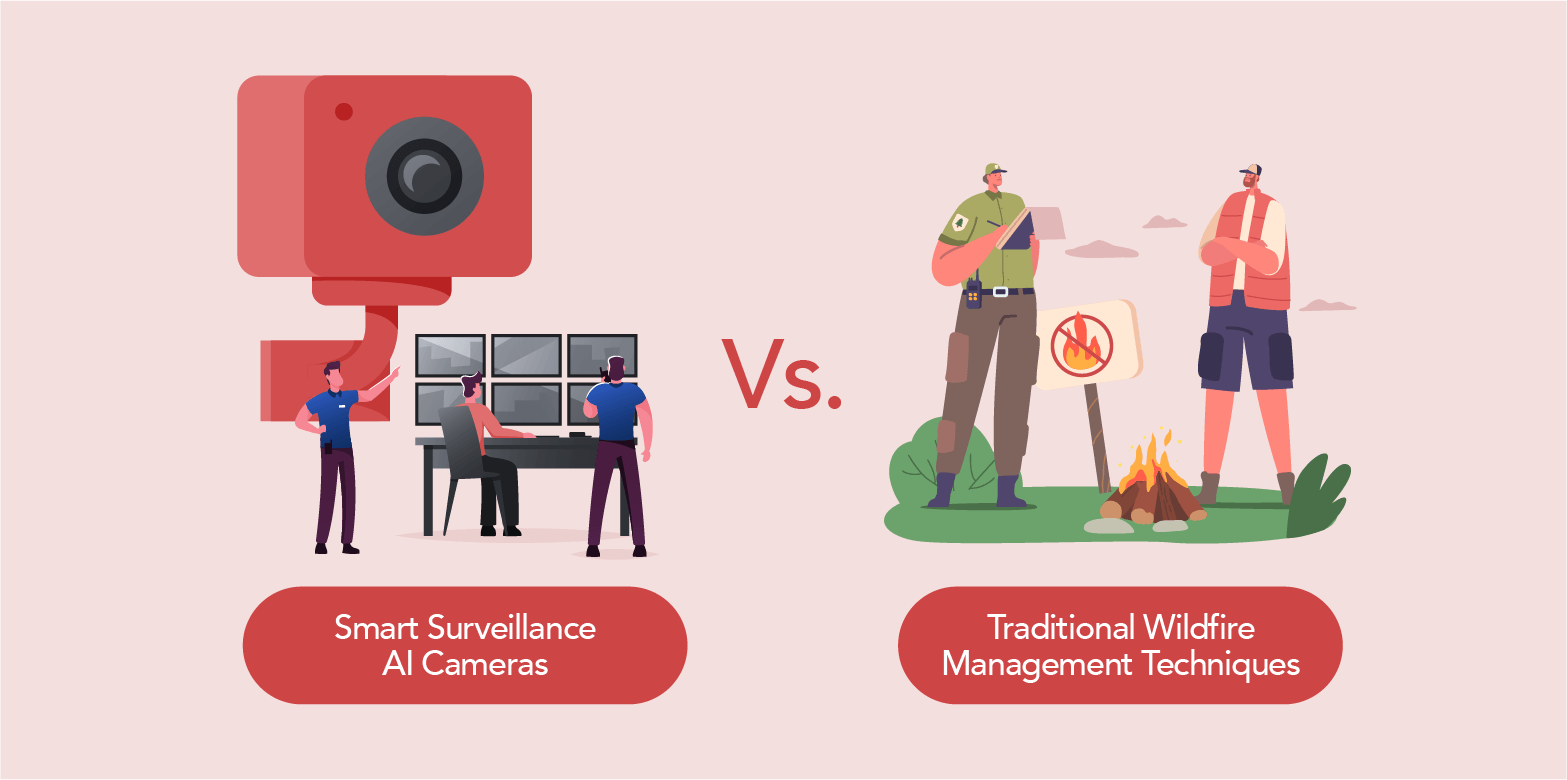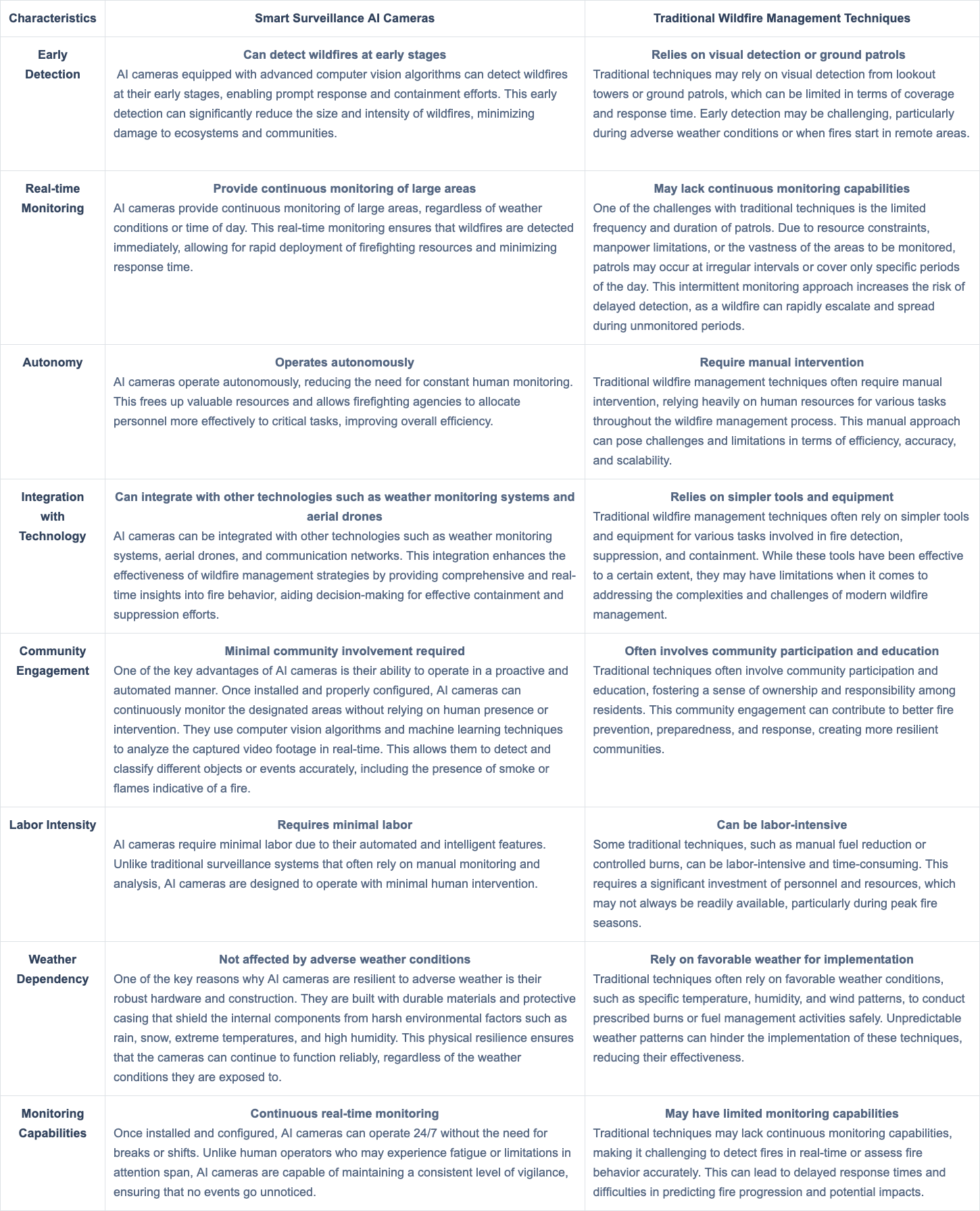Smart Surveillance: How AI Cameras are Revolutionizing Forest Wildfire Management
ALCHERA
May 26, 2023
May 26, 2023
AI Wildfire Detection Cameras: the Future of Forest Wildfire Management
Table of Contents
Forest Wildfire Management: Definition and Techniques
• Definition of ‘forest wildfire management’
• Forest wildfire management techniques development history
Technological Innovations: AI Wildfire Cameras and Smart Surveillance
FireScout: a revolution in forest wildlife management
Smart Surveillance AI Cameras vs. Traditional Wildfire Management Techniques
Leveraging AI WIldfire Detection Cameras for Forest Wildfire Management
The devastating impact of wildfires on our environment and communities cannot be overstated. These natural disasters, fueled by dry conditions and strong winds, have the potential to destroy vast areas of forests, wildlife habitats, and human settlements. Over the years, various techniques and technologies have been developed to mitigate the risks associated with wildfires. One such groundbreaking advancement is the use of AI cameras for smart surveillance in forest wildfire management.
Forest Wildfire Management: Definition and Techniques
Definition of ‘forest wildfire management'
Forest wildfire management refers to the comprehensive set of strategies, techniques, and practices aimed at preventing, monitoring, controlling, and suppressing wildfires in forested areas. It involves a proactive approach to reduce the risk of wildfires and a reactive approach to respond to and manage wildfires when they occur efficiently.
The goal of forest wildfire management is to protect lives, property, and natural resources while maintaining the ecological balance of forest ecosystems. It encompasses various activities such as fuel management, early detection systems, rapid response protocols, and community education.

Forest wildfire management techniques development history
Forest wildfire management techniques have evolved significantly over time as our understanding of wildfires and their behavior has deepened. The history of wildfire management techniques spans centuries and has seen a shift from traditional practices to more scientific and comprehensive approaches. Let's explore the key milestones in the development of forest wildfire management techniques.
Early Practices and Indigenous Knowledge
Indigenous communities around the world have long recognized the importance of fire as a natural ecosystem process. They developed practices such as controlled burns, also known as prescribed fires, to manage landscapes and promote healthy ecosystems. Indigenous peoples understood that periodic low-intensity fires helped maintain a balance between vegetation, wildlife, and fire.
Colonial Era and Suppression Policies
During the colonization period, policies focused on suppressing wildfires rather than embracing the natural role of fire in ecosystems. The belief that all fires were destructive led to aggressive fire suppression strategies. This approach, widely adopted in the 20th century, aimed to extinguish fires as quickly as possible. While it initially succeeded in reducing fire occurrence, it had unintended consequences.

Fuel Accumulation and Intense Fires
Suppression policies resulted in a buildup of fuel, including dead vegetation, fallen branches, and other combustible materials in forests. With time, this accumulation of fuel created conditions for larger, more intense wildfires. The Smokey Bear campaign in the United States, launched in the 1940s, propagated the idea that all fires were bad, further reinforcing the suppression mindset.
Shifting Paradigm and Prescribed Burns
In the late 1960s and 1970s, a paradigm shift occurred as scientific research highlighted the ecological importance of fire. Forest managers and scientists began to recognize the need for controlled burns to reduce fuel loads and restore fire-dependent ecosystems. Prescribed burns, conducted under specific conditions, were reintroduced as a management tool to mimic the natural role of fire and prevent catastrophic wildfires.

Integrated Fire Management
In the late 20th century, the concept of Integrated Fire Management (IFM) gained prominence. IFM emphasizes a comprehensive and multidisciplinary approach to wildfire management. It integrates various techniques, including prevention, prescribed burning, fuel reduction, early detection, and suppression, to achieve sustainable wildfire management objectives.
Fuel Management
Fuel management techniques involve reducing the accumulation of flammable materials in forests. This can be achieved through prescribed burns, mechanical thinning, and manual removal of vegetation. By strategically reducing fuel loads, the intensity and spread of wildfires can be mitigated, improving overall forest resilience.
Early Detection Systems
The development of early detection systems has been instrumental in improving wildfire management. Lookout towers, initially used in the early 20th century, provided a vantage point for spotting fires. Aerial surveillance, such as manned aircraft and helicopters, became widely used to detect wildfires from above. More recently, the use of advanced technologies, including satellite imagery and remote sensing, has enhanced the early detection capabilities.

Weather Monitoring
Monitoring weather conditions is crucial for wildfire management. Meteorological data, including temperature, humidity, wind speed, and precipitation, help predict fire behavior and assess fire danger levels. Weather stations and automated weather monitoring systems provide real-time data, enabling proactive decision-making in fire management operations.
Advancements in Firefighting Techniques
Firefighting techniques have also evolved over time. The introduction of fire retardants, such as fire-suppressing foams and chemical retardants dropped from aircraft, has improved firefighting efficiency. Firefighters now have access to improved personal protective equipment and specialized tools to combat wildfires effectively.
Technological Innovations: AI Wildfire Cameras and Smart Surveillance
Recent technological advancements have brought new possibilities to forest wildfire management. AI cameras equipped with computer vision and machine learning algorithms have revolutionized early detection and monitoring. These cameras analyze live video feeds and can detect smoke, flames, and heat signatures associated with wildfires. Real-time monitoring capabilities of AI cameras allow for early detection of wildfires, enabling rapid response and containment efforts to minimize the spread and damage caused by the fires.
The integration of AI cameras with other technologies, such as weather monitoring systems and aerial drones, provides a comprehensive and real-time understanding of fire behavior, aiding in decision-making for effective wildfire management strategies.
AI cameras also offer the advantage of autonomous operation, reducing the need for constant human monitoring. This frees up valuable resources and allows firefighting agencies to allocate personnel more effectively, focusing on critical tasks and areas of concern.
FireScout: a revolution in forest wildlife management
One notable example of AI camera technology in forest wildfire management is the FireScout system developed by ALCHERA. FireScout combines advanced computer vision and machine learning technologies to deliver accurate and real-time wildfire detection. The system's visual sensors capture high-resolution images and detect heat signatures, enabling precise and reliable wildfire detection even in challenging environmental conditions.
FireScout's AI algorithms analyze the captured data in real-time, differentiating between normal environmental changes and signs of wildfires. This ensures accurate detection while minimizing false alarms. The system can provide valuable insights into fire behavior, such as the rate of spread and the direction of the fire, assisting firefighting agencies in making informed decisions for effective fire suppression.
One of the key features of FireScout is its integration with advanced communication networks. The system can send instant alerts and notifications to firefighting agencies, enabling them to quickly mobilize resources and respond to wildfires in a timely manner. The seamless integration with existing fire management systems allows for efficient coordination among different stakeholders involved in wildfire suppression efforts.
FireScout can also be integrated with existing infrastructure, such as CCTV cameras, reducing equipment investment and maintenance costs. It can manage multiple CCTV cameras with just one GPU, making it cost-effective.
Moreover, FireScout's AI-powered analytics provide valuable data for post-fire analysis and assessment. By analyzing the captured footage and data, firefighting agencies can gain insights into the effectiveness of their response strategies, identify areas for improvement, and refine their wildfire management techniques.
The implementation of FireScout and similar AI camera systems in forest wildfire management has shown promising results. By combining early detection, real-time monitoring, and data-driven decision-making, these systems have the potential to revolutionize the way we manage wildfires and minimize their devastating impacts.
Smart Surveillance AI Cameras vs. Traditional Wildfire Management Techniques

Smart surveillance AI cameras have emerged as a promising solution for early detection and monitoring. However, it is important to assess their effectiveness and compare them to traditional wildfire management techniques to understand their respective pros and cons. By exploring the advantages and limitations of each method, we can gain valuable insights into how to best protect our forests and communities from the devastating impacts of wildfires.

Leveraging AI WIldfire Detection Cameras for Forest Wildfire Management
Forest wildfires pose a significant threat to our environment, wildlife, and communities. However, with advancements in technology, we now have powerful tools at our disposal to enhance wildfire management strategies. AI cameras, such as the FireScout system developed by HERA, offer real-time monitoring, early detection, and accurate wildfire analysis, enabling rapid response and effective firefighting efforts.
By leveraging the capabilities of AI and computer vision, these smart surveillance systems provide valuable insights into fire behavior, aid in decision-making, and improve overall coordination among firefighting agencies. The integration of AI cameras into existing wildfire management networks brings us one step closer to proactive and efficient wildfire prevention and suppression.
As we continue to face the challenges of climate change and increasing wildfire risks, it is crucial to embrace innovative technologies like AI cameras to protect our forests, wildlife, and communities. Smart surveillance through AI cameras is a game-changer in forest wildfire management, offering a promising solution to mitigate the destructive impact of wildfires and preserve our natural ecosystems for generations to come.
...
...
